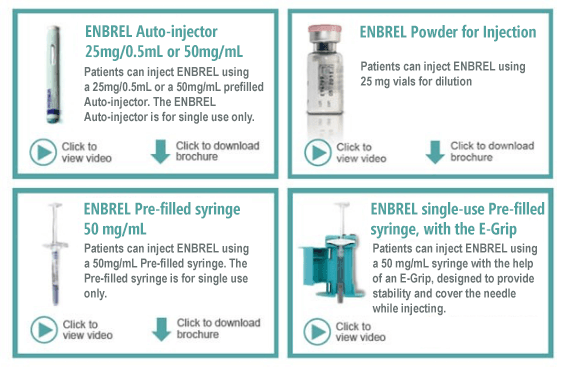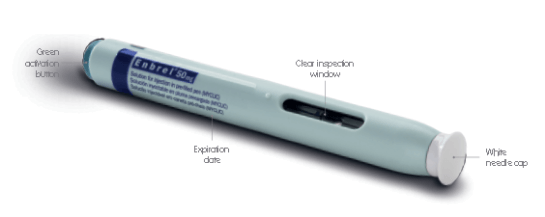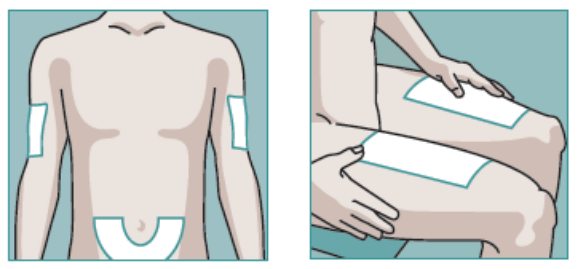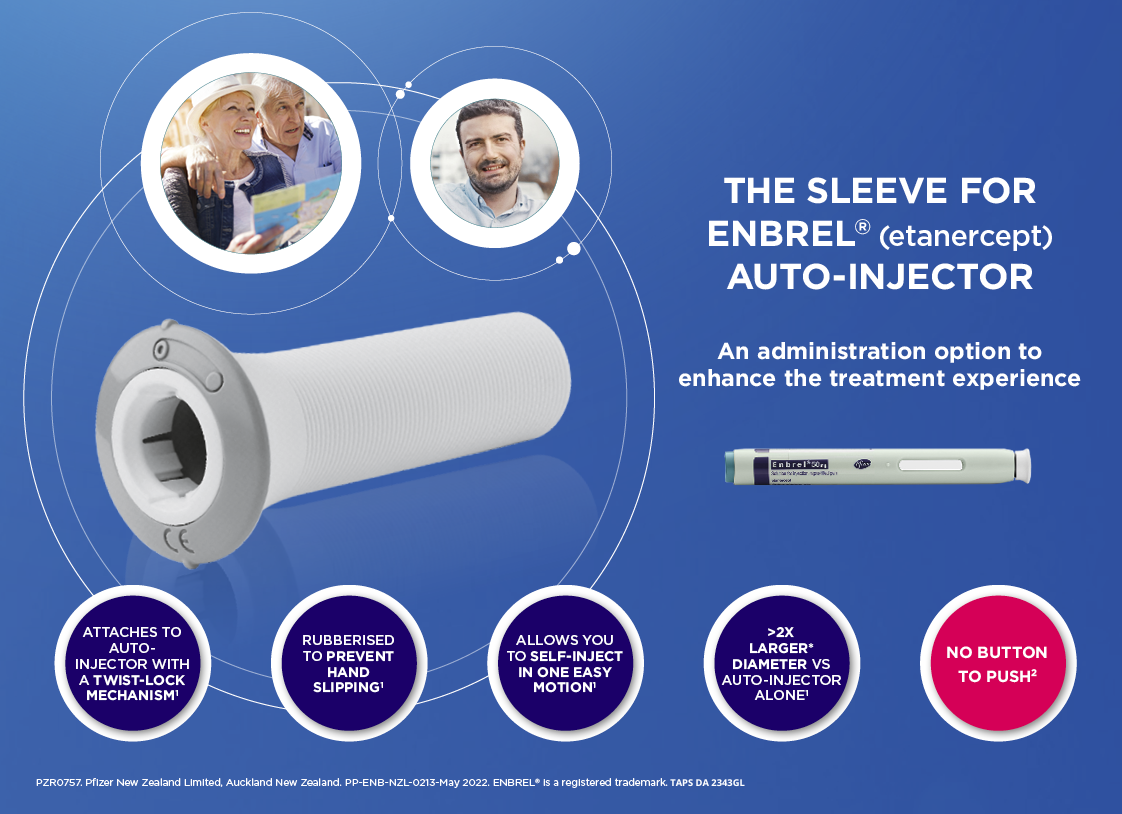Taking Enbrel®

DOSING INSTRUCTIONS
The following section explains how to prepare and administer Enbrel® using each of the different methods for injecting yourself.
Dosage
You will have been prescribed one of the following:

You should continue to inject Enbrel® for as long as your doctor recommends.
Never inject more than the dose recommended by your doctor.
If you feel that the effect of Enbrel® is too strong or too weak, talk to your doctor or pharmacist.
If you forget:
- Within 48 hours of your scheduled dose time: Inject the next dose as soon as you remember.
- More than 48 hours since the last dose was due: Wait for the next scheduled dose.
- Do not use a double dose to make up for the dose that you missed.
- If you are not sure what to do, ask your doctor or pharmacist.
If you have trouble remembering to use your medicine, ask your pharmacist for some hints.
If you take too much (overdose)
If you think that you or anyone else may have used too much Enbrel®, even if there are no signs of discomfort or poisoning:
- Immediately telephone your doctor or
- Poisons Information Centre 0800 POISON or (0800 764 766), or
- Go to your nearest hospital Accident and Emergency clinic
- Take the original medication box with you – even if it is empty
You may need urgent medical attention. There is very limited data on overdose with Enbrel®.
ENBREL® INJECTION DEMOS
Enbrel® is injected just under the skin in a part of the body that is easy to reach. The best places are the front of your thighs, your abdomen (not too close to the belly button) or outside of your upper arms.
Step-by-step injection demos
You or a caregiver should receive training from your healthcare professional for the first injection of Enbrel®. You can also view step-by-step instructions below.

The most common side effect is a mild reaction in the area where Enbrel® was injected, including: itching, bruising, redness, bleeding, swelling, pain or hardness around the injection site. These reactions generally do not occur as often after the first month of treatment.
If you are concerned about injection site reactions, make sure you contact your healthcare professional.
Disposal
Always use the sharps container provided to dispose of used Auto-injectors or Pre-filled syringes. Once the container is full, consult the needle destruction brochure in your patient pack for instruction on responsible needle disposal.
Phone 0800 Enbrel® (working hours 10am-7pm) for a new sharps container to be sent to your home. Or you can register for Enbrel® Resources which offers you helpful tips and information about needle disposal and exchange. You can also order replacement sharps bins and other resources here.
Swabs and cotton balls can be placed in the garbage unless otherwise instructed by your doctor, nurse or pharmacist. Keep out of the reach of children.
PREPARING TO INJECT
- 1) Clean your surface.
- 2) Select a well-lit, flat, working surface and clean in advance.
- 3) Select your Enbrel® injection.
- 4) Take one injection out of the carton and place it on the flat work surface.
- 5) Return any remaining Enbrel® preparations to the refrigerator (between 2° to 8°C).
- If you have any questions about storage view the storage instructions on this site or contact Pfizer Medical Information for further instructions on 0800 675 229.
- 6) DO NOT shake the Enbrel® Auto-injector or vial.
- 7) Check the expiration date on your Enbrel®
Enbrel® Auto-injector:

If the expiration date has passed, do not use it, and contact your pharmacist for assistance.
- 8) Wait 15 to 30 minutes to allow the Enbrel® injection to reach room temperature.
- 9) DO NOT remove the needle cover while allowing it to reach room temperature.
- 10) DO NOT warm Enbrel® in any other way (e.g. do not warm it in a microwave or in hot water).
- 11) Assemble any additional supplies that you may need for your injection.
These could include a cotton ball or gauze and a sticking plaster. - 12) Wash your hands with soap and warm water.
Choosing your injection sites
The best places are the front of your thighs, your abdomen (not too close to the belly button) or outside of your upper arms.
Pick a different injection site every time – at least 3 cm from an old site.

When injecting, remember that you need a firm surface to push against. So if you are using the abdomen, for example, you may need to pinch the skin before injecting.
Note: this is particularly important if using the Auto-injector, which has a safety mechanism that requires a small amount of pressure to be applied before injection.
![]() SEE INJECTION DEMOS
SEE INJECTION DEMOS

Once you have chosen your injection site, wipe the area with an alcohol swab and allow it to dry. DO NOT touch this area again before giving the injection.
You are now ready to inject your Enbrel®.
Notes:
- do not inject into scars or stretch marks or any area where the skin is tender, red, bruised or hard
- if you have psoriasis, try not to inject directly into any raised, thick, red, or scaly skin patches (‘psoriasis skin lesions’ or ‘plaques’)
do not use the outside of the upper arms for self injection. Only use this area if you are administering the injection for someone else.

To learn more about the Sleeve for the Enbrel Auto-Injector including how the sleeve works, click here: VIEW VIDEO
To order the sleeve for the Enbrel Auto-injector along with other resources, please click here

